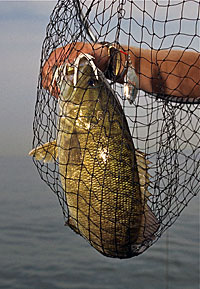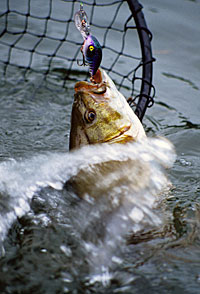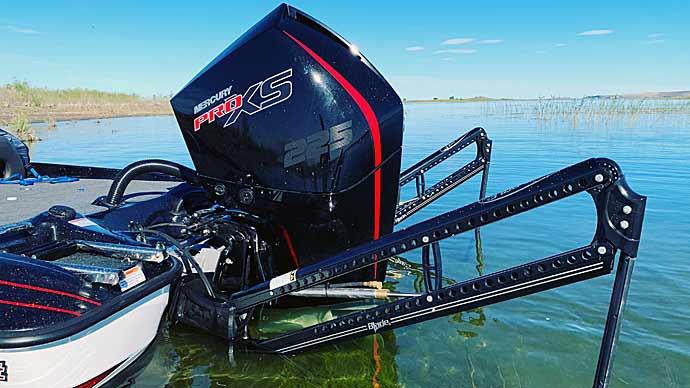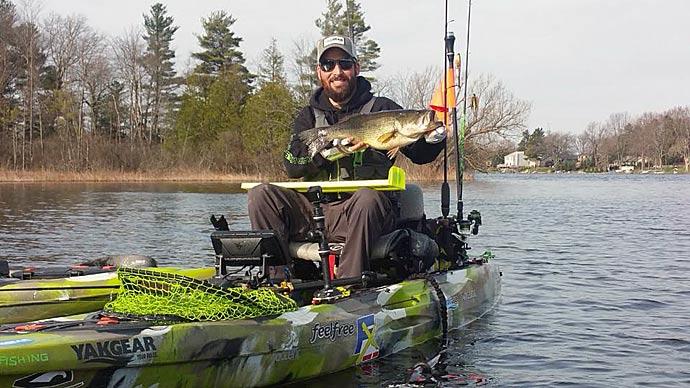
The two most critical and exciting junctures when fishing is at the strike and when the fish comes to the net. If the fish strikes aggressively and the hooks are sharp, the fish gets hooked solidly, and battling the fish is essentially a matter of rod pressure and patience. The most tenuous moment is when the fish nears the boat. With less line out, there is less stretch. Mistakes are magnified. Too much pressure can pull hooks out; not enough, and the fish can shake free.
Assuming neither happens, netting must be a coordinated effort between the angler and the person wielding the net. If done correctly, the fish is in the net and the boat before knowing what happened. Approach the netting process in an unsynchronized and haphazard manner, and you’ll be lamenting the big one that got away. If you’re just fun fishing, it will be the source of a story retold many times. It can have more drastic consequences during a tournament or on a guided trip.
Part of the equation for successfully netting fish is to have the right tool for the job. Anglers should consider the type and size of the fish they expect to encounter to pick the proper net. Elements to consider are hoop diameter and size, handle length and composition, and net bag depth, color, and composition. A perfect net for one type of fish may be inadequate for another.

Bass anglers should consider Frabill’s line of Conservation Series nets. Conservation Series nets are designed with safe catch and release in mind. All nets feature 100% knotless mesh netting, eliminating injuries commonly caused by sharp knots. Knots also tend to scrape away the slime layer on fish, leaving them vulnerable to infection. Flat, linear bottoms reduce fish rolling and support the weight of the entire fish. It has a coating that prevents hooks from entangling in the net and facilitates quick release. Mesh guard hoops resist wear and significantly extend the life of the net. The 20” x 23” and 23” x 26 Conservation Series nets should meet the needs of most bass fanatics.
While the Conservation Series nets are meant to treat fish with a gentle touch, they are not wimpy. The impression you get when picking up one of the nets for the first time is strength. The heavy-duty aluminum handle is strong enough to be used as a push pole. Been there; done that. I’ve seen lighter yokes on an ox. The net yoke is rugged, thick, nearly indestructible plastic that will endure a lifetime of use and features Frabill's exclusive patented Pow'R Lok automatic yoke system. The Mesh Guard Hoop means the bag loops are recessed into the hoop instead of loped around it, which leaves one less thing to snag on when getting ready to net a fish. The solid black hoop and sure-grip handle are a nice finishing touch.
Another option for bass anglers is Frabill’s Crankbait Net. It took two years of development, but Frabill finally came up with a net specifically designed to keep crankbaits, stickbaits, and other multi-hook lures from becoming entangled in the netting. We’ve all been there. Net a fish hooked on a crankbait, and it starts flopping, creating a snarl nightmare. Not anymore. With the Crankbait Net, your net-tangling frustrations are over. The Crankbait Net is available in 20” x 23” to 23” x 26” models with various handle lengths.

Bass boats are not known for having an overabundance of storage space, or you might not use a net the majority of the time, but it would feel better if you had one on board just in case. Taking up less space but available to land the catch of a lifetime is where a folding net might be an alternative.
Frabill offers a couple of options when it comes to folding nets. The Folding Net comes in 18” x 16” and 22’ x 20’ sizes that take up little space when collapsed but are readily available when it comes time to scoop a 10-pound toad. The Power Stow Net comes in 20” x 24” and 14” x 18” models. The hoop in the Power Stow folds in half, and the handle retracts for easy storage.
Handle length is essentially a matter of personal preference but depends on the height of your transom and the amount of room you have for storage. Handles can stretch from 2 to 8 feet or more. It’s always better to have a net handle that’s too long than one that’s too short.
Bag and hoop color are a consideration. Most anglers prefer net bags made from a dark material to prevent spooking fish before netting. Wave a flashing net over a fish near the surface, and he’s likely to panic. Dark, anodized hoops and handles and dark bags help prevent panicking fish.

Netting fish is an art form. When done correctly, the process is a coordinated effort using a quick, fluid motion. The angler needs to stay at the back or side of the boat to keep track of the fish until the fish is ready to be netted. Only then should the person with the net step in front of the angler. The angler should lift and bring the fish closer as the netter brings the net up under the fish. The angler needs to be prepared if the fish makes a sudden run or burst. If done correctly, the netter should only have to lift the net as the angler leads the fish over the hoop.
One important point is knowing when a fish is ready to be netted. The fish should be within easy netting distance and show signs of tiring. Usually, the fish will be lying on its side. The idea is to slip the net under the fish headfirst without touching the fish until it is centered in the net. You can then put the net handle straight up in the air, effectively closing the net bag, or swing the hoop into the boat. Be careful of nets with long handles. Wielding a long handle around while paying attention to the fish and not to others in the boat can result in a knock on the noggin or worse.
Most fish are lost at the boat because of indecision or being too anxious. Have a positive attitude that you can easily scoop the fish. Wait until the fish is well within range and shows signs of tiring. Don’t reach. More fish are lost at this critical juncture because the netter reaches for the fish while the angler gives the fish slack. If you reach too far, the net will flow out in front of the hoop, and the fish is likely to get caught in the netting before he’s safely in the net. The hooks get caught in the net, and the fish shakes free. To prevent this, don’t reach and hold the bag against the handle until the fish is over the net. Then open your hand to release the bag. Once the fish is in the boat, the angler needs to release the tension on the line or give some slack to prevent the hook from flying out and causing injury.
Netting must be a coordinated effort. Done right, it means sweet success and high fives all around.




